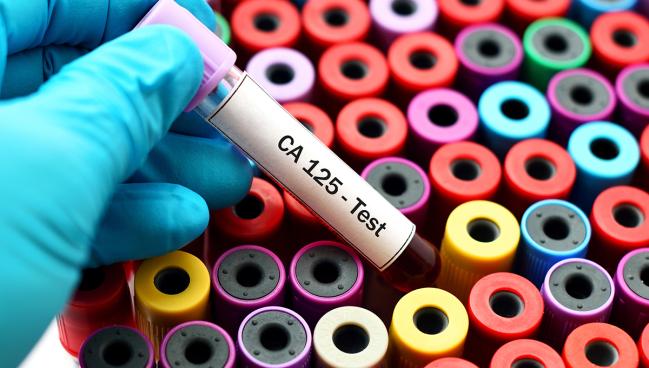Congestion Biomarker CA125 Signals Worse Outcomes in Ambulatory HFrEF
The results suggest CA125 could be complementary to NT-proBNP, but it’s not quite ready for clinical use, a researcher says.

Carbohydrate antigen 125 (CA125), a biomarker that initially emerged in the setting of ovarian cancer and has since been studied in acute heart failure (HF) as a marker of congestion, appears to provide important prognostic information in patients with chronic ambulatory heart failure with reduced ejection fraction (HFrEF), according to a post hoc analysis of the DAPA-HF trial.
Patients with high levels of CA125 at baseline were more likely to have a first episode of worsening HF or cardiovascular death (primary outcome) than were those with lower levels, even after adjustment for NT-proBNP and other biomarkers (adjusted HR 1.53; 95% CI 1.24-1.89). Similar relationships were seen for the individual components of that endpoint, all-cause mortality, total HF hospitalizations/CV death, and HF death (HRs 1.40-1.98).
Moreover, researchers led by Kieran Docherty, MBChB, PhD (University of Glasgow, Scotland), showed that the beneficial impact of dapagliflozin (Farxiga; AstraZeneca), was not significantly affected by baseline CA125 level.
Since one of the purported mechanisms of benefit of the sodium-glucose cotransporter 2 (SGLT2) inhibitors in HFrEF is through decongestion, it was hypothesized that patients with a higher CA125 level indicative of more-severe congestion would have the most to gain. But that wasn’t seen.
“I think this fits with other data suggesting that although a diuretic mechanism of action may be one amongst many mechanisms underlying the benefits of SGLT2 inhibitors, it’s not a predominant mechanism of the benefits,” Docherty told TCTMD.
The analysis was published online today ahead of the July 11, 2023, issue of the Journal of the American College of Cardiology.
Assessing CA125 in Ambulatory HF
The investigators performed a post hoc analysis of the DAPA-HF trial, in which the SGLT2 inhibitor significantly reduced the risk of worsening HF or CV death and improved quality of life in chronic HFrEF patients, regardless of diabetes status. Overall, 3,123 of the 4,774 trial participants had available data on CA125 measured at baseline and/or 12 months. The median CA125 level at baseline was 13.04 U/mL, with 12.2% coming in above 35 U/mL (upper limit of normal).
As anticipated, Docherty said, an elevated CA125 level was associated with findings suggestive of more-severe HF, including higher natriuretic peptide levels and more-frequent reports of peripheral edema on the Kansas City Cardiomyopathy Questionnaire (KCCQ).
In addition, higher CA125 levels were associated with worse clinical outcomes regardless of how the analysis was performed—comparing levels above versus below the upper limit of normal, broken into quartiles, or in a continuous fashion.
A landmark analysis showed that compared with patients who had a low CA125 at both baseline and 12 months, risk of the primary outcome over the next 12 months was greater in patients who had a CA125 level that went from low to high (HR 5.90; 95% CI 3.94-8.83) and those who had high CA125 at both time points (HR 5.13; 95% CI 3.53-7.48). A doubling of CA125 over the first year increased risk by 1.77-fold.
As for the beneficial impact of dapagliflozin over the course of the DAPA-HF trial, it remained consistent regardless of baseline CA125 level for the primary outcome, secondary morbidity/mortality outcomes, and the total symptom score of the KCCQ (P > 0.10 for all interactions).
Overall, there was a numerical placebo-corrected decline in CA125 level of 5.2% with dapagliflozin during the trial, but the difference was not significant (P = 0.07). The fall was greater, and significant (11.7%), however, in the subset of patients who had a prior HF hospitalization.
Because CA125 was measured only at baseline and 1 year, this analysis cannot inform whether dapagliflozin had an earlier effect on the biomarker, Docherty said, adding that it also can’t provide information on the effects of SGLT2 inhibition on CA125 in patients admitted with decompensated HF and significant congestion. “Further studies of the relationship between dapagliflozin and CA125, or any SGLT2 inhibitor and CA125, in that setting would be of great interest.”
CA125 or NT-proBNP?
The researchers also explored the interplay between CA125 and NT-proBNP, first showing that risk of the primary outcome increased across NT-proBNP quartiles within each quartile of CA125, with no significant interaction between the two biomarkers and risk of worsening HF or CV death (P = 0.10 for interaction). Patients with the highest levels of both biomarkers had more than triple the risk of the primary outcome compared with patients with the lowest levels of both (adjusted HR 3.43; 95% CI 2.22-5.30).
Asked about the relative utility of CA125 versus NT-proBNP, Docherty said the latter is a good marker of elevated left-sided filling pressures, whereas there is some evidence to suggest that CA125 is a better marker of elevated right-sided filling pressures.
“It may be that the use of both biomarkers together may identify patients who have more-significant congestion than just NT-proBNP alone, but this would have to be confirmed in a prospective study,” he said.
Using CA125 in Daily Practice
Commenting for TCTMD, Antoni Bayes-Genis, MD, PhD (University Hospital Germans Trias i Pujol, Badalona, Spain), lead author of an accompanying editorial, said the study provides evidence that CA125 is a good biomarker of congestion that can be used to monitor worsening heart failure or monitor patients as they transition home after discharge. It may also improve the assessment of prognosis in these patients, even on top of information on natriuretic peptides.
“It’s very good that we can have CA125 in our armamentarium because it’s cheap, because it’s available in almost all portfolios of chemical laboratories in every hospital, and because it’s not affected by renal function, it’s not affected by age, and it’s not affected by any of these other comorbidities very frequently present in heart failure,” Bayes-Genis said. “And it’s a good biomarker to identify worsening heart failure and to identify congestion, so it’s just incorporating a biomarker that’s going to allow us to do more precision medicine in heart failure.”
And, as suggested by Docherty, it is complementary to NT-proBNP, providing more information on right-sided HF, Bayes-Genis said. Plus, CA125 is not influenced by age and renal function, like NT-proBNP. “In a way, by combining the two of them, we get a more-comprehensive assessment of global cardiac dysfunction,” he explained.
Bayes-Genis said CA125 is not a widely used biomarker in HF, but added that his group uses it in daily practice as an indicator of congestion. For example, if a patient with acute HF is being discharged and their NT-proBNP is going down but their CA125 remains high, they will be asked to come back in 1 to 2 weeks for an assessment of how well diuretic therapy is working. If the patient is decongesting properly, CA125 will have come down. But if CA125 remains high, it’s likely that that will be accompanied by a rise in NT-proBNP.
“This is also an indication that we are in trouble, that this patient needs close monitoring, eventually requiring admission to the hospital for IV diuretics,” Bayes-Genis said, adding that this should prompt the treating physician think about what can be done to improve the patient’s status.
Ultimately, the goal is to identify quality biomarkers and use them to move toward greater use of precision medicine in HF, he indicated. “We are trying to copy what oncologists have been successfully doing over the past 10 years, and we need to go in that direction to be more successful.”
For Docherty, however, additional research is needed to assess the utility of CA125 as a biomarker that can be used to diagnose or monitor congestion or to guide treatments. “I think larger studies need to be done, particularly in the setting of outpatients, to further validate the use of this biomarker in routine clinical practice,” he said.
Todd Neale is the Associate News Editor for TCTMD and a Senior Medical Journalist. He got his start in journalism at …
Read Full BioSources
Docherty KF, McDowell K, Welsh P, et al. Association of carbohydrate antigen 125 on the response to dapagliflozin in patients with heart failure. J Am Coll Cardiol. 2023;82(2):142-157.
Bayes-Genis A, de la Espriella R, Núñez J. CA125 for fluid overload monitoring: a new life for an old tool. J Am Coll Cardiol. 2023;82(2):158-160.
Disclosures
- DAPA-HF was funded by AstraZeneca. Roche Diagnostics provided CA125 tests at no cost.
- Docherty reports that his employer, the University of Glasgow, has been remunerated by AstraZeneca for his work on the DAPA-HF and DELIVER trials. He has received speaker fees from AstraZeneca and Radcliffe Cardiology; has served on advisory boards for Us2.ai and Bayer AG; has served on a clinical endpoint committee for Bayer AG; and has received grant support from AstraZeneca, Roche, and Boehringer Ingelheim, outside the submitted work.
- Bayes-Genis reports having received personal fees from or having served on advisory boards of Abbott, AstraZeneca, Boehringer Ingelheim, Bayer, Novartis, Novo Nordisk, Roche Diagnostics, and Vifor Pharma.





Comments